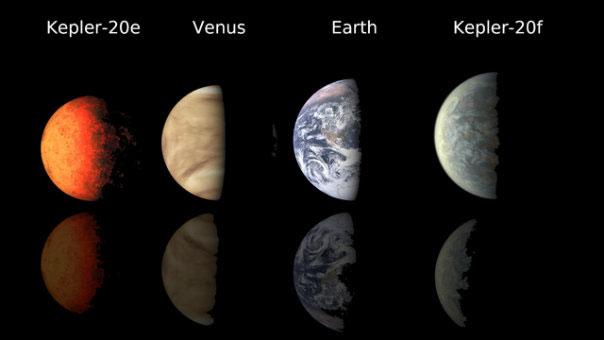Does 'twin' planets with Earth exist?
In order for a life similar to Earth to exist on another planet, scientists think aliens must also have three vital components: organic structural molecules can form complex structures, energy to operate these molecules and liquid water so that they can creep into everything. In short, only planets similar to Earth can contain all three.
>>> NASA finds life-like planets like Earth
If a planet is closer to its star than the distance from Earth to that planet (assuming that the star is about the same size as our sun), all the water on the planet's surface will evaporate because high temperature. If it is too far away, all the water on the surface will freeze. Similarly, planets larger than Earth will contain too much gas and do not have a stable surface to form the ocean while smaller planets will not have enough gravity to be able to form a similar planet. self like earth. In addition, after studying 'potential planets' that could survive alien life, there is only one 'strange planet' that is the Holy Grail.
According to a recent announcement on December 20 in Nature, a team of researchers from NASA's Kepler observatory announced the discovery of a planet that could have life. , or a planet outside our solar system is about the same size as the earth. Another world with the name Kepler-20e and 20f circled around the orbit of a star with the name Kepler-20, 950 light years from the earth and 0.87 and 1.03 times, respectively. land.

With such a size, the planet's gravity will be strong enough to make it solid enough like Earth instead of containing a giant mass of gas like Jupiter. Guillermo Torres, a member of Kepler's team based at the Smithsonian Center for Astrophysics, Harvard said: 'According to new theories, the materials inside this planet could be iron at the central core. and surrounded by a sillicate layer ' . If it is true these planets will in turn have 1.7 and 3 times the mass of the Earth.
Essentially these planets are about the same size as the Earth but can it sustain life? The possibility of this happening is not great. Torres interviewed on Life's Little Mysterious: 'The climate here is too hot to create an ecosystem . ' Both Kepler-20e and Kepler-20f have extremely close orbits to their stars, with a year consisting of only 6 days and 20 days. "For a planet closer to a star, its temperature is up to 1,000 degrees Celsius (1,800 degrees Fahrenheit), and with a further planet the temperature is around 700 degrees Celsius (1,300 degrees Fahrenheit)," Torres said .
However, with this temperature, liquid water can hardly exist. Besides, without any large ocean, as well as no original evidence of the existence of water on both planets, we can conclude that there is almost no form of water. live, in the opinion of scientists.

On the other hand, is there a form of living entity that does not need any water that exists on Kepler-20e and 20f? Torres said that he encountered this question many times: 'Why do we think life on it must be the same as our Earth? Because we don't have any evidence for another life so we have to start from what we know. If this happens, it's actually quite strange. '
Two weeks ago, Kepler's team announced the discovery of another planet that could almost survive an ecosystem, but could not say for a number of different reasons. Dave Charbonneau, another member of Harvard's Kepler research team based in Cfa, said: 'We discovered about Kepler -22b - a planet with the right temperature for life, but this planet size too big. Besides, there is another planet of the same size as the Earth but too hot to survive. ' - He concluded: ' What we have to do next is find a planet that is all converging. Advantages: The size is similar to Earth and has the right temperature, which is the most important thing '.
- Discover 32 new planets
- The Milky Way has billions of planets close to Earth
- Will there exist aliens?
- Discover more than 700 planets outside the solar system
- Journey to find Earth's twin brothers
- Are there more 'livable' planets than Earth?
- Found 2 planets 'twin' different from the Solar System
- Discovering the twin planet of Jupiter
- The Milky Way might contain 10 billion Earth-like planets
- Journey more than two decades to explore the outer planet
- Discovered 'Earth materials' in 18 other planetary systems
- Discovering 'Earth Stone' has 3 suns at the same time
 Van Allen's belt and evidence that the Apollo 11 mission to the Moon was myth
Van Allen's belt and evidence that the Apollo 11 mission to the Moon was myth The levels of civilization in the universe (Kardashev scale)
The levels of civilization in the universe (Kardashev scale) Today Mars, the sun and the Earth are aligned
Today Mars, the sun and the Earth are aligned The Amazon owner announced a secret plan to build a space base for thousands of people
The Amazon owner announced a secret plan to build a space base for thousands of people